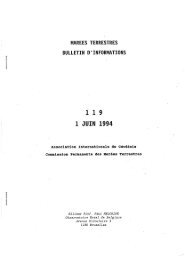marees terrestres bulletin d'informations - Université de la Polynésie ...
marees terrestres bulletin d'informations - Université de la Polynésie ...
marees terrestres bulletin d'informations - Université de la Polynésie ...
You also want an ePaper? Increase the reach of your titles
YUMPU automatically turns print PDFs into web optimized ePapers that Google loves.
Hydrological Signals due to the Seasonal Variation of Lake Nasser<br />
and its Effect to the Surrounding Crust as Deduced from the Tidal<br />
Gravity Observations<br />
Hassan, R. M., E.M. Ab<strong>de</strong>lrahman, A. Tealeb, K.H. Zahran and G. Jentzsch<br />
Abstract<br />
Impounding of Lake Nasser started in 1964 and reached the highest water level so far in 1978 with a<br />
capacity of 133.8 km 3 . It is extending 500 km in southern Egypt and northern Sudan, thus forming the<br />
second <strong>la</strong>rgest man-ma<strong>de</strong> <strong>la</strong>ke in the world. The water level fluctuates between 168m and 178m, the<br />
cycle being divi<strong>de</strong>d into four different periods of inflow, stability, discharge, and stability again. The<br />
variation of the mass of the water of the reservoir changes the potential field either by loading or by<br />
change of the ground water level. To <strong>de</strong>tect these signals two years of continuous gravity<br />
measurements (from the year 2002 to the year 2004) have been used from a tidal station installed<br />
very close to the Lake. A combined plot of water level variation and residual gravity shows that the<br />
residual gravity follows water level variations with a time <strong>de</strong><strong>la</strong>y. Two methods have been used in the<br />
current study to evaluate the gravity variations in the tidal records due to variations of water level at<br />
Lake Nasser. In the first method, the data were divi<strong>de</strong>d into blocks, each block represents an epoch of<br />
a certain water level in the <strong>la</strong>ke. These blocks reflect the situation in the <strong>la</strong>ke during the <strong>de</strong>crease,<br />
stability, and increase of water level. The tidal parameters at different blocks with different water<br />
levels show some changes. These changes reach up to 4% in amplitu<strong>de</strong> factors, and 0.5° in phase<br />
shifts. The variations in the e<strong>la</strong>stic parameters follow to some extent the variations of water level in<br />
the <strong>la</strong>ke. In the second method, cross-corre<strong>la</strong>tion was applied between residual gravity and change of<br />
water level in the <strong>la</strong>ke. Generally, a mo<strong>de</strong>rate corre<strong>la</strong>tion coefficient (0.556) between residual gravity<br />
variation and water level variation, and a weak corre<strong>la</strong>tion coefficient (0.480) between residual<br />
gravity and ground water variation were recognized. Corre<strong>la</strong>tion coefficients of selected blocks<br />
follow to some extent the values of water level variation on one si<strong>de</strong> and ground water variation on<br />
the other si<strong>de</strong>. The study shows that variations of the Lake level affect the surrounding crust<br />
significantly. Variation of the <strong>la</strong>ke has to be mo<strong>de</strong>lled and consi<strong>de</strong>red in the geo<strong>de</strong>tic and gravity<br />
observations in this region if higher accuracy is to be achieved.<br />
1. Introduction<br />
The filling of <strong>la</strong>rge reservoirs changes the stress regime, either by increasing vertical stress<br />
(compression) by loading or increasing pore pressure through the <strong>de</strong>crease of effective normal<br />
stress (Snow, 1972; Bell and Nur, 1978; Simpson, 1986; Roeloffs, 1988). At Lake Nasser, water<br />
level fluctuates four times during the year, according to the cycle of charge (inflow) and discharge<br />
(outflow), followed each by a period of stabilisation. The variations of water level in the <strong>la</strong>ke affect<br />
the dynamic stability of the area, either by variable induced loading or variation in the un<strong>de</strong>rground<br />
water level. On the other hand, the analysis of tidal gravity observations at Aswan tidal station,<br />
which is very close to Lake Nasser, shows discrepancies between the observed and synthetic tidal<br />
parameters. These discrepancies may be due to variations in water <strong>la</strong>ke level. In the region of Lake<br />
Nasser, the Nubian sandstones cover a <strong>la</strong>rge area, with a porosity of about 25%. So, any change in<br />
water level in the <strong>la</strong>ke changes the un<strong>de</strong>rground water level. Seepage of water of the <strong>la</strong>ke into the<br />
un<strong>de</strong>rground <strong>de</strong>pends on the types of rocks in the un<strong>de</strong>rground, their state of weathering and<br />
tectonic influences (formation of clefts and cavities of different sizes). The run-off <strong>de</strong>pends on the<br />
properties of superficial material, the evaporation on meteorological parameters (air temperature,<br />
humidity of air, and wind) and p<strong>la</strong>nt cover, etc. In hydrologic mo<strong>de</strong>lling, generalized input data and<br />
parameters are commonly used, which are representative for a certain area or a certain period of<br />
11807



